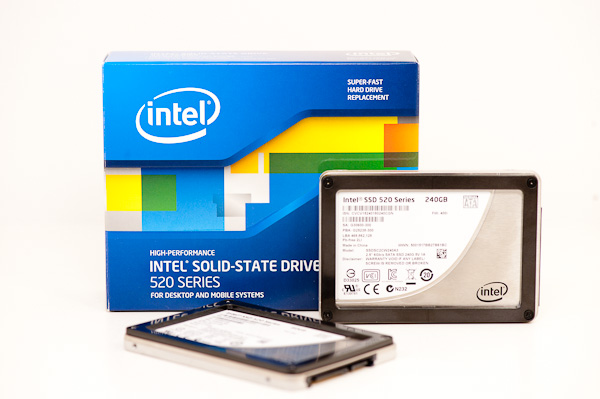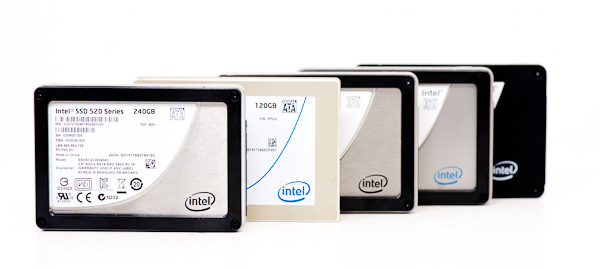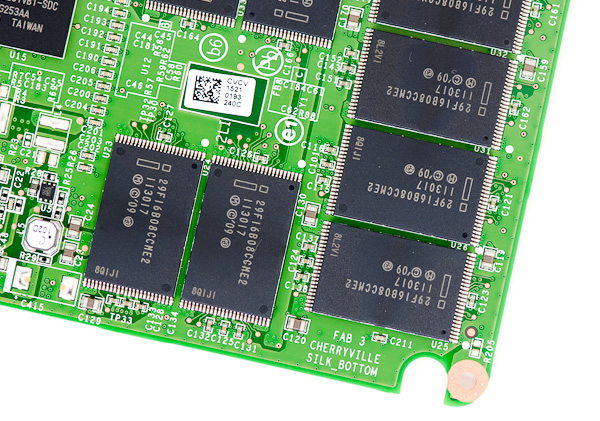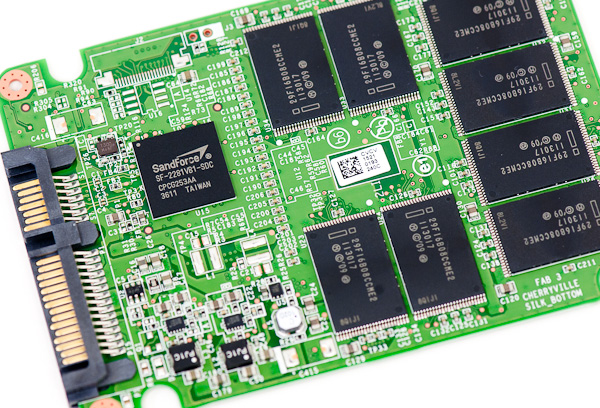Intel SSD 520 Review: Cherryville Brings Reliability to SandForce
by Anand Lal Shimpi on February 6, 2012 11:00 AM ESTIntel was rumored to be working on a SandForce based drive for several months now, but even the rumors couldn't encapsulate just how long Intel and SF has worked on this drive. According to Intel, the relationship began 1.5 years ago. Still lacking a 6Gbps controller of their own and wanting to remain competitive with the rest of the market, Intel approached SandForce about building a drive based on the (at the time) unreleased SF-2281 controller. Roughly six months later, initial testing and validation began on the drive. That's right, around the time that OCZ was previewing the first Vertex 3 Pro, Intel was just beginning its extensive validation process.
Codenamed Cherryville, Intel's SSD 520 would go through a full year of validation before Intel would sign off on the drive for release. In fact, it was some unresolved issues that cropped up during Intel's validation that pushed Cherryville back from the late 2011 release to today.
Intel's strenuous validation will eventually make SandForce's drives better for everyone, but for now the Cherryville firmware remains exclusive. Intel wouldn't go on record with details of its arrangement with SandForce, but from what I've managed to piece together the Intel Cherryville firmware is exclusive for a limited period of time. That exclusivity agreement likely expires sometime after the SF-2281 is replaced by a 3rd generation controller. There are some loopholes that allow SandForce to port bug fixes to general partner firmware but the specific terms aren't public information. The important takeaway is anything fixed in Intel's firmware isn't necessarily going to be fixed in other SF-2281 based drives in the near term. This is an important distinction because although Cherryville performs very similarly to other SF-2281 drives, it should be more reliable.
As Intel has been working on this firmware for quite a while, it's likely that the 520 uses an older branch of the SF-2281 firmware that has been updated over the past twelve months.
The BSOD is Back, but Not on Intel
Back in October SandForce announced that it had discovered a firmware issue that resulted in unexpected BSODs on SF-2281 drives on certain platforms. Why it took SandForce several months to discover the bug that its customers had been reporting for a while is a separate issue entirely. SandForce quickly pushed out the firmware to OCZ and other partners. Our own internal testing revealed that the updated firmware seemed to have cured the infamous BSOD.
Just as background, our SSD testing is rarely over once the review goes live. Any drive we recommend gets tossed into a primary use machine somewhere within the company. We keep track of drive behavior, including any bugs or performance issues over time. This long term testing process takes place over months. The results of these long term tests are folded into future reviews and recommendations.
The BSOD is caused by a bug in SandForce's power state logic that ultimately results in the drive disconnecting from the system while it's running. It turns out that Windows isn't a fan of you hot un-plugging the drive it's running on, which results in the BSOD. We had two systems that exhibited the BSOD, both of which were fixed by the update last October.

As luck would have it, our own Brian Klug happened to come across an unexpected crash with his 240GB non-Intel SF-2281 based SSD two weeks ago when he migrated it to another machine. The crash was an F4 BSOD, similar in nature to the infamous BSOD issue from last year. While two of the systems we reproduced the BSOD bug on were cured by last year's firmware update, Brian's system (an X58/Core i7 build) was BSODing regularly playing Battlefield 3. Games end up being a great way to trigger the SF-2281 BSOD issue as they frequently switch between periods of idle and load, which does a good job of stressing the power state logic in SandForce's firmware. I immediately sent Brian an Intel SSD 520 to see if the BSOD remained on Intel's drive. Switching to Cherryville caused Brian's BSODs to go away. Indeed most end user reports of SF-2281 BSODs went away with the fixed firmware, but we've still heard of isolated issues that remain unresolved. Whatever Intel has done with the 520's firmware seems to have fixed problems that still remain in the general SF-2281 firmware.
This is actually a dangerous precedent as it means one of two things. The first possibility is that SandForce has been made aware of flaws in its current firmware and chooses against (or is legally prevented from) disclosing it to its partners. The second possibility, and arguably even worse for SandForce, is that Intel was able to identify and fix a bug in the SF-2281 firmware without SandForce knowing it existed or was addressed. I suspect it's the former but as no one is willing to go on the record about the Intel/SandForce agreement I can't be certain.
Intel did go on record saying that the 520 is expected to have far fewer F4/F7 BSODs than any other SF-2281 drive. I asked Intel if I should read into the phrase "far fewer", but the answer was no - the 520 is expected to have similar reliability to the Intel SSD 510 and 320.
At the end of the day that's what Intel really brings to the table with the 520. As you'll soon see, performance isn't very different compared to other SF-2281 based drives. Intel's biggest advantage comes from the unique firmware that ships with the drive. Intel is also quick to point out that while other SF-2281 manufacturers can purchase the same Intel 25nm MLC NAND used on the 520, only Intel's drives get the absolute highest quality bins and only Intel knows how best to manage/interact with the NAND on a firmware level. While it's nearly impossible to prove most of this, the fact that we're still able to reproduce a BSOD on the latest publicly available SF-2281 firmware but not on the SF-2281 based Intel SSD 520 does say a lot about what you're paying for with this drive.
And you are paying a premium for the 520 compared to other SF-2281 based SSDs on the market today:
| Intel SSD 520 Price Comparison | |||||||
| 60GB | 120GB | 180GB | 240GB | 480GB | |||
| Intel SSD 520 (SF-2281) | $149 | $229 | $369 | $509 | $999 | ||
| Kingston HyperX (SF-2281) | N/A | $205 | N/A | $420 | N/A | ||
| OCZ Vertex 3 (SF-2281) | $95 | $190 | $240 | $375 | $850 | ||
| Samsung SSD 830 | $110 | $220 | N/A | $360 | $800 | ||
Last year Intel hinted at a move from the consumer market to enterprise server and client markets. The 520's higher price likely won't matter there, but for consumers the higher price is noticeable - particularly with good options from companies like Samsung now available on the market.














138 Comments
View All Comments
Lord 666 - Monday, February 6, 2012 - link
Is there a link or reference on compatibility for 320 drives in HP servers?One element that was not mentioned was encryption of the 520 and use within servers.
Mr Perfect - Monday, February 6, 2012 - link
Intel is also quick to point out that while other SF-2281 manufacturers can purchase the same Intel 25nm MLC NAND used on the 520, only Intel's drives get the absolute highest quality bins and only Intel knows how best to manage/interact with the NAND on a firmware level.Intel forgot to mention that they don't have to pay a markup on their own flash. Or do they intend to pass that on the consumer? Maybe accounting steps in and makes the SSD department pay up so the flash division doesn't loose profit?
Jovec - Monday, February 6, 2012 - link
Actually, the probably do pay a markup. Often times with large companies a division actually "buys" resources/parts from another. Yes, it is mostly accounting, but the flash division can book flash sales to their SSD division as revenue. The SSD division cannot just factor in flash memory "at cost" when developing their SSD product lines.NitroWare - Monday, February 6, 2012 - link
From what you can disclose, what has Intel acutally being doing during development ? Have they been debugging a branch of the firmware or have they been doing accelerated lifetime testing as part of their QANot much use debugging the firmware ( although required for OEM ) if the things don't last as long as others in real world use specially enterprise.
Intel is only offering 5yrs because they can, because they have tighter control over the project but not full control. Its a token guesture. I wonder if the terms of the warranty cover any applications or just typical desktop/notebook use.
Intel only 'covered' overclocking recently, so it would not be suprising if there are some clauses in the terms of use of Cheryville.
Most of the launch reviews have claimed the drive is 'more reliable'? The consumer is supposed to take their word for it? SSD are not cheap and EVERY Intel product ever made has errata, many marked as nofix, many marked as fix in sw, many as fix in next hw.
The e-ink on the embargoed reviews isn't even dry and claims of reliabililty.
P54C had erratta, PIIX4 had errata, many slot1 Desktop boards had erratta, FWH had erratta, ICH5 had errata, some early 775 boards needed a BOM update list to support core2duo, many GMA have erratta, SNB-E has erratta.
The firmware issue for other OEM customers can be seen more critical than Intel getting their product right. Many users or resellers do not even know there is a firmware update for their product. Look what happened with Crucial, the fix for their problems only came out recently.
Kingston were even still shipping outdated specs on the boxes on their product and nowhere is there any mention that the user should even consider looking for firmware. As of Novemeber/December last year, that particular drive did not have 332 preloaded at the factory.
SSD vendors are still claiming the fix is 'optional and should only be applied if issues occur' to cover themselves. This drive being released is just more shiny or is a swiss army knife with more tools in it. It does not change the status quo with SF or any other third party controller.
Validation Lists are lacking for many SSDs as some are seen as enthusiast toys yet and It is very hard to answer somonewhen they ask if an enthusiast grade SSD using SF is suitable for a server, especially if the server is to use a RAID HBA and Linux.
I will also note that the testbed used for this review is using an older version of the Intel RST Driver, the changelog for each release is quite signficant and there is focus on improving SSD performance and reliabililty.
The latest BIOS for motherboards updates the Intel RST OROM improving compatibilty for AHCI, especially RAID. Latest stable Intel RST should be used by end user. Intel is churning out the updates more frequently than the past which is good to see.
Then theres third party controllers. AMD is really lax with SATA updates, let alone the third parties. How is a professional supposed to put trust in a third party SATA or USB controller when the shipping firmware is labeled 'version 0.9' ?
I am even on the fence about reviewers using stable platforms for reviews. I like to update drivers whenever possible and recommend drivers be kept up to date, I can understand the need to keep a stable platform, but in the real world bugs get fixed, updates get released and people apply these updates.
I am really glad Intel took their time with this product, as there is a pointless marketing flooding of identical SSDs but what now and as we know Intel take their time and do things right with foward looking farsightness but in real world use it will take the masses a long time to discover any flaws especially if they are of a life-expectancy nature.
Anand Lal Shimpi - Monday, February 6, 2012 - link
It's far more complex than just accelerated lifetime testing. Intel's validation encompasses that as well as widespread compatibility testing, field testing and workload testing. As we've seen in the past, it's by no means perfectly complete but it's generally more robust than anything the competition is able to do on a regular basis.In our review we presented a situation where the 520 was indeed more reliable than standard SF-2281 drives.
We use a stable platform for performance tests but we always do functional testing with the latest available drivers/BIOSes (this was the case in Brian's BSOD testbed).
Take care,
Anand
NitroWare - Monday, February 6, 2012 - link
Anand I am with you on Intel's validation processes being 200% of whats needed and then some, many forget where Intel products end up - they end up in places of serious use, enterprise desktops, developers, F1 Teams, Military, OEM and whitebox Integrators.There was even a quote from John Carmack in the PR...
One GPF or one BSOD thats driver related should not be tolerated and I am in the belief that any error can be debuged, traced and fixed by any sw or hw vendor. Its more the fact that do they want to for whatever reason inernal or external.
You are right in your latter definition of reliable and I at least know that if you say that word to your readers you can back it up, but everyone else took the bait on a general level which is why I waited for your personal overview as you would say more than just that 'it is fast'
You were one of the few who bothered to dive deeper to uncover the truth behind all SSD in your vlog on youtube and edtorials.
The way I am defining reliable is over the life cycle of the drive though, that you can depend on the drive to always work and not die/lose data randomly.
Field testing - that worked great for the Vertex with ICH10R.. I think there are still conemporary boards out there that don' have patches for the early Vertexs.
Its worse with laptops, I am aware of Thinkpads with issues with third party SSDs.
Several server /hosting companies are interesting in putting 520s in RAID 10 with a HBA and have told me they went with those simply because the 710 is too expensive, the 710 is A$700 for 100GB at the moment where as the 520 is several hundred less let alone a 'generic' 240GB 2281 drive.
When you are quoting a client for a server, they may be picky on the final price and downgrade it .
The things better work. The irony is the HBAs in question are LSI and IMO I think LSI do not care (yet) about SSD interop with their own companion products. .
Morg. - Tuesday, February 7, 2012 - link
Intel's validation is great.Some issues arise from the chipsets ... a spot where Intel (even when they're not doing shady stuff) can easily make important adjustments knowingly.
Overall I would still think the Intel drive will be more *reliable* but when you're talking raid arrays .. who cares ?
And putting two vertex3-s instead of an intel 710 is called upgrading : more resilience, more speed, more space for the same price.
(the minimal fine-tuning related to ssd power states is a mere detail on a server that's not even running windows in the first place)
Same goes for consumers imho .. if you're going to market a 3% reliability advantage at 45% price, I sure hope nobody buys it.
Morg. - Tuesday, February 7, 2012 - link
You presented nothing Anand, you just said what Intel paid you to say.You cannot measure that this disk is more reliable because you have NOT tested a thousand drives in a thousand configs, i.e. the scenarios that actually caused so many vertex 3's to fail.
So the only conclusion one can draw from your review, you included, is that the computer that had a BSOD-ing SF-2281 did not BSOD with the intel 520 .
And that is not what I would call "indeed more reliable".
OTOH, gotta keep your sponsor money and I respect that - just cut the bullcrap ;)
seapeople - Tuesday, February 7, 2012 - link
Brilliant, you've figured it out! The reason Anand has been recommending SandForce drives for the last three years is because Intel told him they would eventually get on board with SandForce, and therefore paid him to preemptively pump up the SandForce drive reputation.This is sheer genius.
NitroWare - Wednesday, February 8, 2012 - link
"Overall I would still think the Intel drive will be more *reliable* but when you're talking raid arrays .. who cares ?"When the HBA vendor or even motherboard sata controller hasnt validated RAID SSD proply it does matter. Look at the lists for many popular RAID HBA, not all mechanical HDD are listed,even ones which are intended for RAID.
"And putting two vertex3-s instead of an intel 710 is called upgrading : more resilience, more speed, more space for the same price."
Two instead of 1 - fair enough but RAID 1 will no eliminate any bugs in a drive especially if the drives are identical and have logic flaws rather than part failure.
Say you had two M4s with the counter issue in RAID, RAID doesn't solve anything and server/data redundancy comes in. Drive RAID helps for when a drive may fail randomly. If all the drives in your array have the same flaw/known issue then you might be in trouble.
"the minimal fine-tuning related to ssd power states is a mere detail on a server that's not even running windows in the first place"
Firmware is firmware. AHCI is AHCI. I don't think anyone has done finite analysis on wether any issues can come up in Linux with the multitiude of controller hw and firmware, drivers, kernels combinations and so on.
Good RAID HBA are only validated for particular OSes. Just too many combinations.
"Same goes for consumers imho .. if you're going to market a 3% reliability advantage at 45% price, I sure hope nobody buys it. "
Consumers will never buy the more expensive part. Enthusiasts are cheapskates.
These drives arn't meant for the average consumer. They are meant for power users , enthusiasts, pros and entry enterprise. 3% matters. By that notion, you disapprove of ECC in workstations and servers as the spend is too much even though this isn't for Consumer.
"You cannot measure that this disk is more reliable because you have NOT tested a thousand drives in a thousand configs, i.e. the scenarios that actually caused so many vertex 3's to fail."
At a launch like this, the product is only available a short time before launch. To do indepth projects such as long testing over time is something some vendors are not interested in with some media and some regions.
How many users are willing to wait, 1,2,3 months for the outcome of a long term test for something 'this hot' . They will go buy the Force 3 for $180 because they can't wait.
"So the only conclusion one can draw from your review, you included, is that the computer that had a BSOD-ing SF-2281 did not BSOD with the intel 520 ."
WHat did the other embargo reviews do ? they all ran the standard suite and claimed it was faster and more reliable. How many did a plugtest with AMD, JMB, ASMedia, Marvel, Intel, Apple SATA., HBA, etc
"OTOH, gotta keep your sponsor money and I respect that - just cut the bullcrap "
I do not see anyone else in a similar position to him championing that SF improve their products. In all of his vlogs and editorials he explains the difference in operation between SandForce and Intel fairly objectively. Anything further is irrelevant.
I do not think the industry has been at the mercy of a third party vendor where there is a cloud over the reliability of their product for some time. We have to go back several years when certain video and audio vendors had poor or non existent support, but even those are accessories and did not affect data.